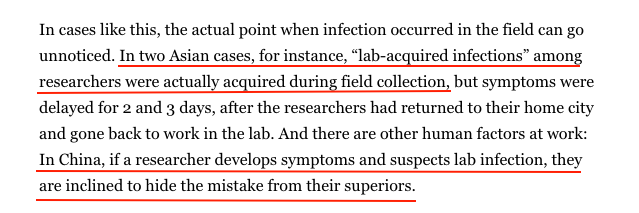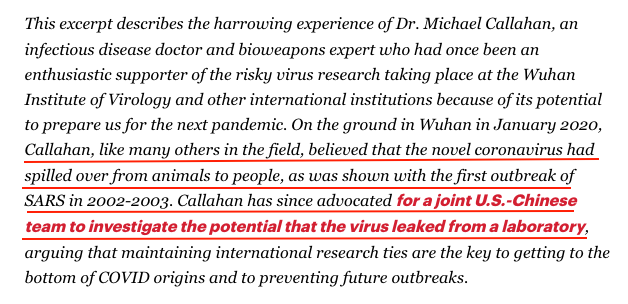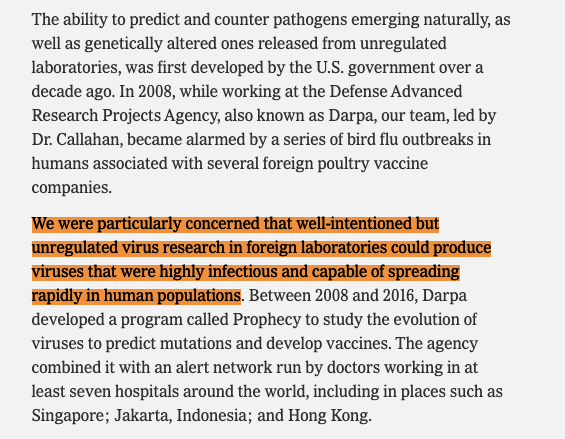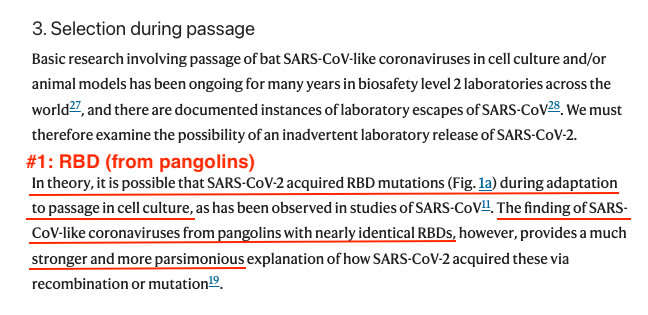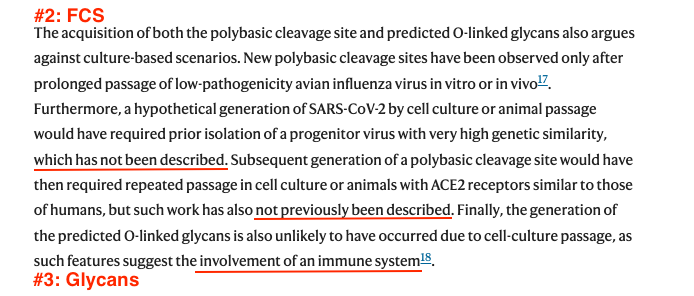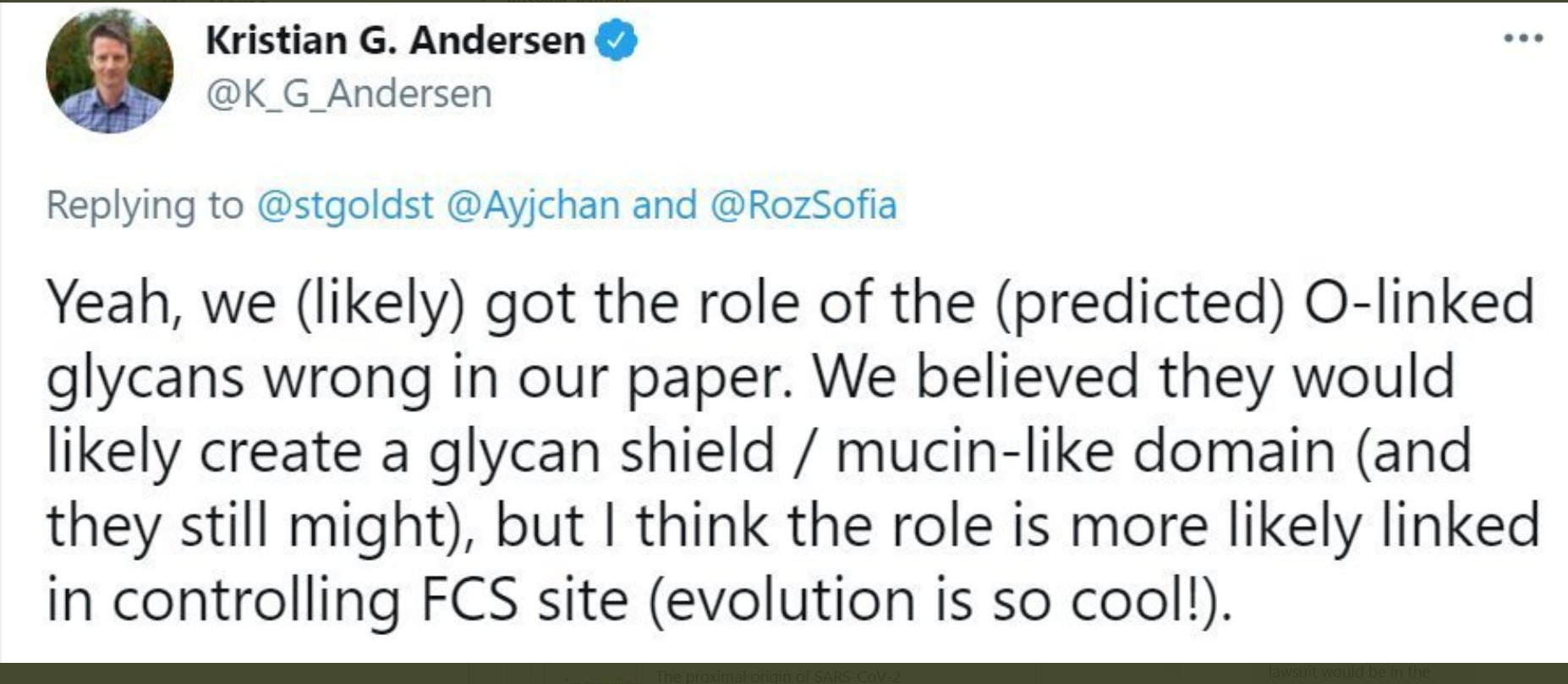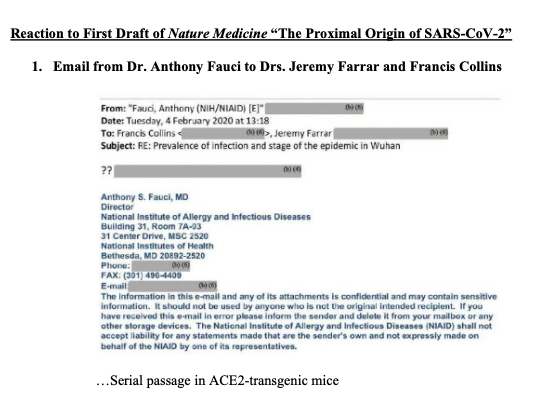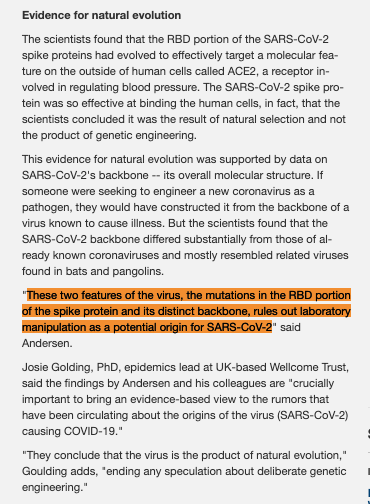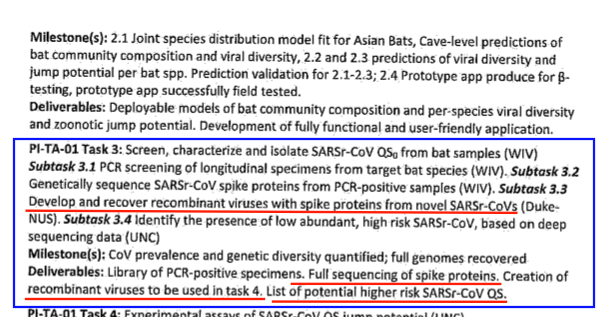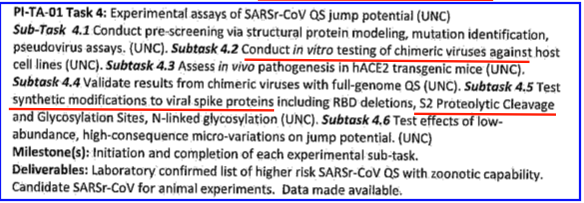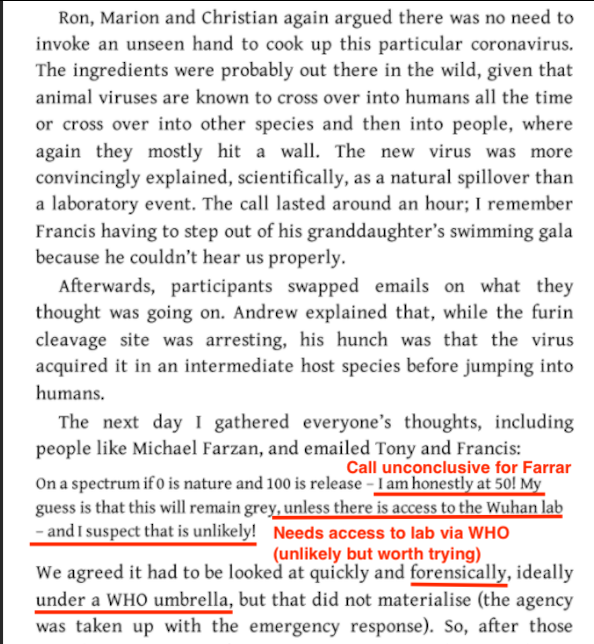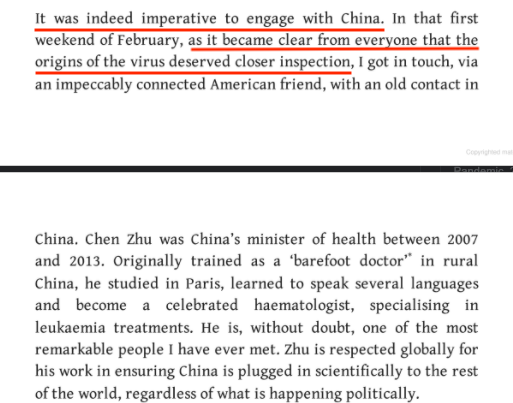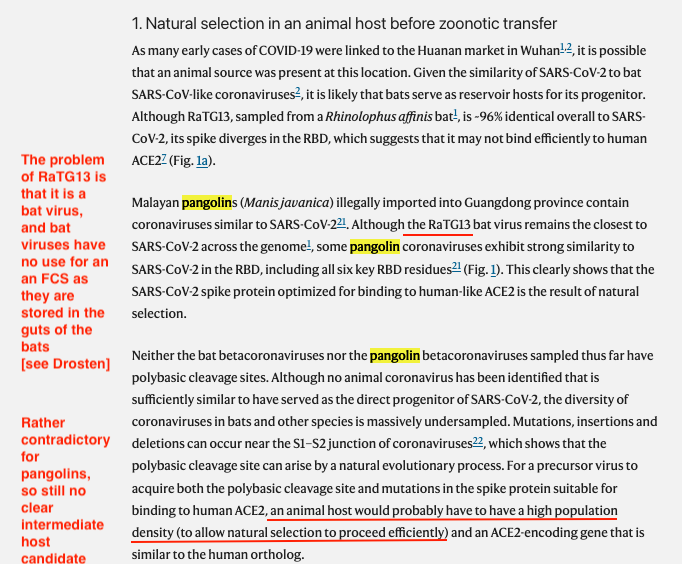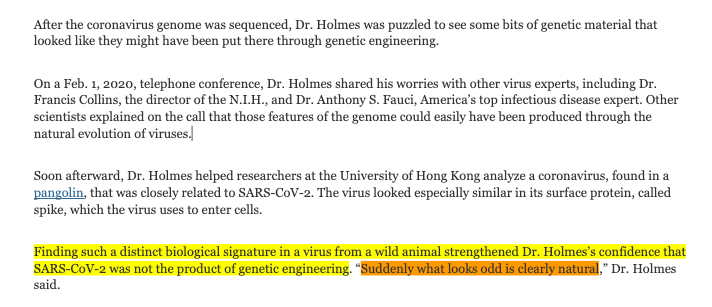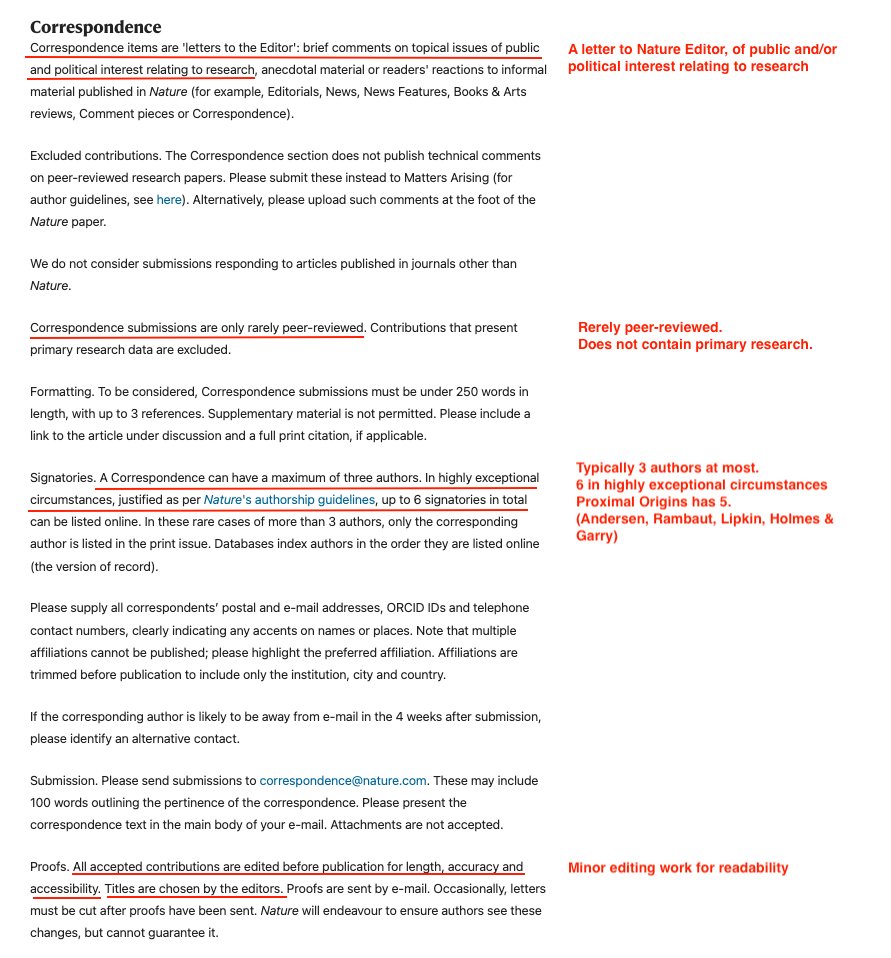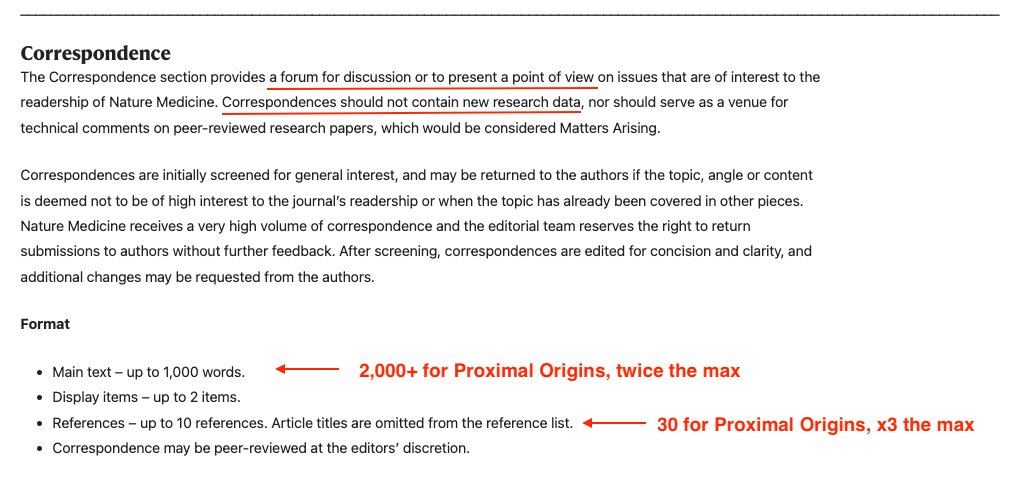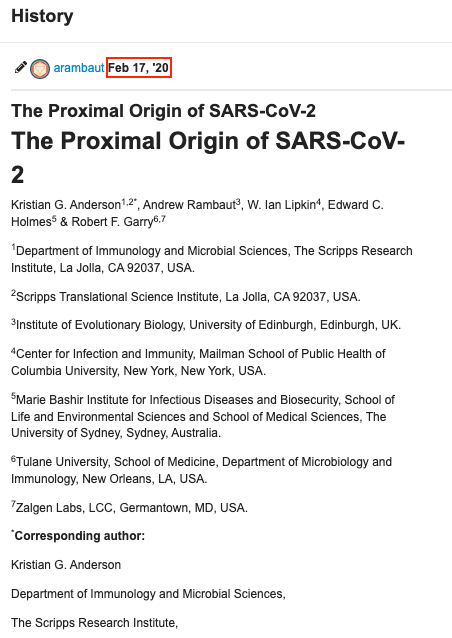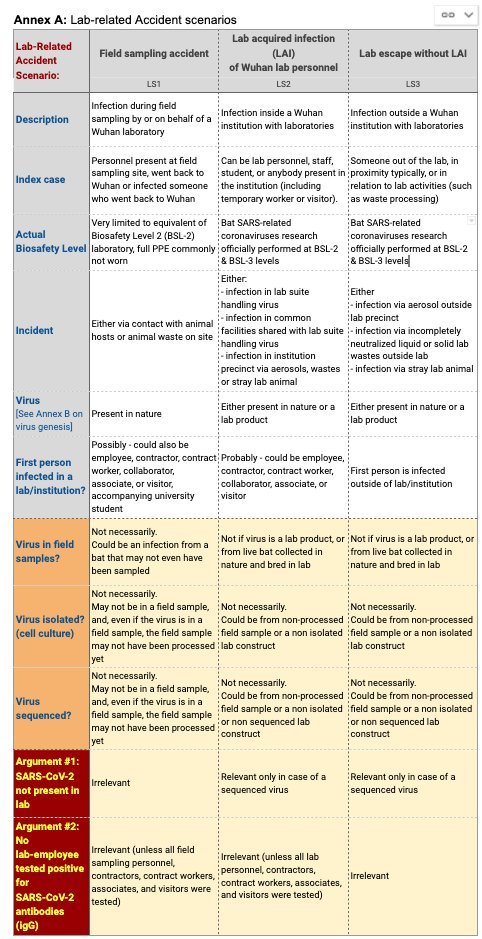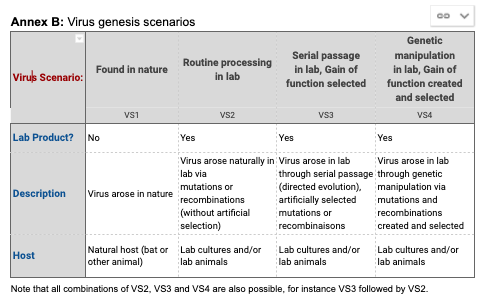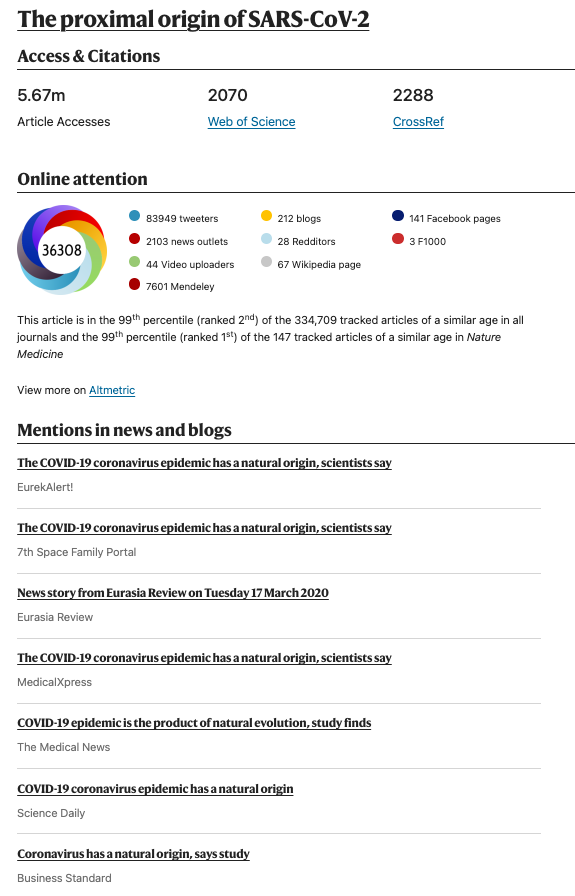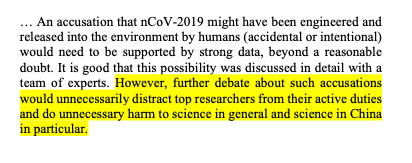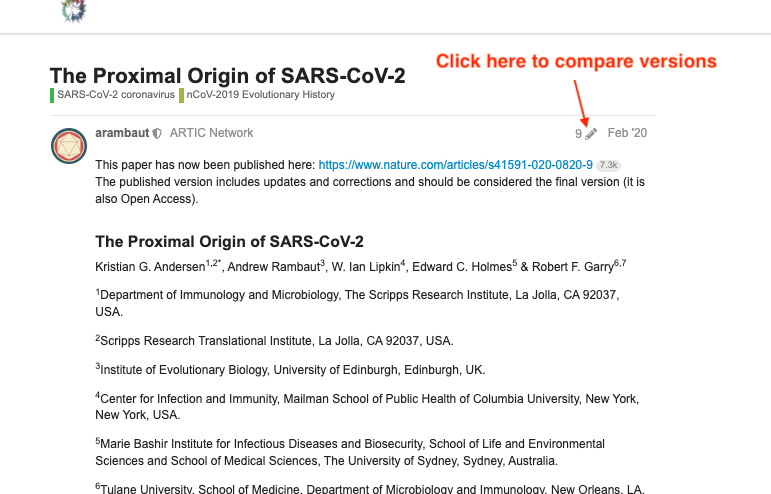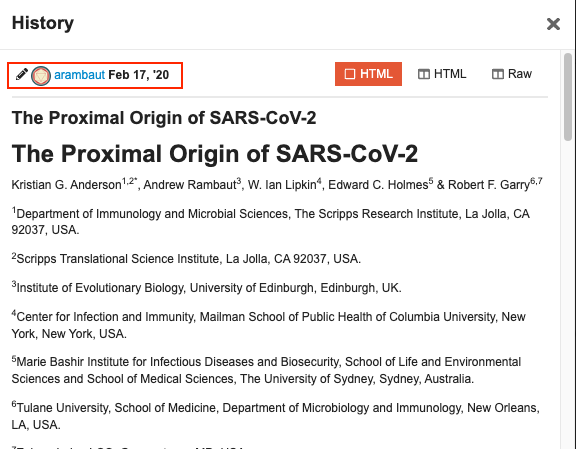Thread
1/ In my previous thread I shed some light on the Politics behind the genesis of Proximal Origins, especially in relation to the WHO.
I will now look more at some of the scientific debates that were part of its genesis.
I will now look more at some of the scientific debates that were part of its genesis.
2/ Proximal Origins considers three hypotheses:
1. Natural selection in an animal host before zoonotic transfer
2. Natural selection in humans following zoonotic transfer
3. Selection during passaging
1. Natural selection in an animal host before zoonotic transfer
2. Natural selection in humans following zoonotic transfer
3. Selection during passaging
3/ Issue 1:
Other possibilities are simply ignored, such as infection during field sampling, especially with some pre-or-asymptomatic young samplers.
A possibility that has been highlighted by Callahan (of DARPA) - not exactly a conspiracy theorist.
politico.com/news/magazine/2021/09/15/covid-origin-investigation-china-cooperation-511898
Other possibilities are simply ignored, such as infection during field sampling, especially with some pre-or-asymptomatic young samplers.
A possibility that has been highlighted by Callahan (of DARPA) - not exactly a conspiracy theorist.
politico.com/news/magazine/2021/09/15/covid-origin-investigation-china-cooperation-511898
4/ As an aside, Callahan, a former Covid-19 special adviser to the assistant secretary for public health preparedness at the Department of Health and Human Services, has evolved his position on a possible lab origin over time - which is commendable:
www.rollingstone.com/culture/culture-features/covid-19-origin-first-shots-excerpt-1267694/
www.rollingstone.com/culture/culture-features/covid-19-origin-first-shots-excerpt-1267694/
6/ Issue 2:
Proximal Origin rejects serial passaging with 3 rather flimsy arguments:
The 1st argument (RBD) is a rather weak parsimony argument that additionally uses the debunked pangolin papers.
Proximal Origin rejects serial passaging with 3 rather flimsy arguments:
The 1st argument (RBD) is a rather weak parsimony argument that additionally uses the debunked pangolin papers.
7/ That parsimony argument is rather self-defeating, as it calls to the rescue the RBD of a virus
- found in a pangolin, most unlikely animal for an intermediary host.
- from a batch of animals that were trapped 1,000+ km from Wuhan
www.technologyreview.com/2021/03/26/1021263/bat-covid-coronavirus-cause-origin-wuhan/
- found in a pangolin, most unlikely animal for an intermediary host.
- from a batch of animals that were trapped 1,000+ km from Wuhan
www.technologyreview.com/2021/03/26/1021263/bat-covid-coronavirus-cause-origin-wuhan/
9/ The last argument against passaging, the o-glycans, was simply wrong and like a lot of the letter, overreaching:
10/ Anyway, the whole passaging section in Proximal Origin looks like a bit like a half-baked quick job.
For a bit of context, at the same time as he was praising the evolutionary analysis draft Fauci wondered just as much:
?? [What about serial passage in ACE2 transgenic mice]
For a bit of context, at the same time as he was praising the evolutionary analysis draft Fauci wondered just as much:
?? [What about serial passage in ACE2 transgenic mice]
11/ and not only Fauci, but Ian Lipkin himself (one of the co-authors of Proximal Origin) raised that serious possibility in very clear language one week later.
That was on the 11 Feb so only 6 days before a near final version of Proximal Origins on virological.org.
That was on the 11 Feb so only 6 days before a near final version of Proximal Origins on virological.org.
12/ Moving on, after dismissing an infected sampler and serial passaging, Proximal Origin is left to basically argue that:
- all the basic virus pieces are already in nature (in various corners of the map)
- but not known to be in the Wuhan labs
- all the basic virus pieces are already in nature (in various corners of the map)
- but not known to be in the Wuhan labs
13/ This somehow ignores the very possibility that a Wuhan lab could create such a virus from these various pieces found scattered in nature, plus some passaging for fine tuning.
Exactly as DEFUSE effectively proposed to do.
A project that China could easily fund itself.
Exactly as DEFUSE effectively proposed to do.
A project that China could easily fund itself.
14/ Anyway, an anonymous WHO collaborator had a very good take on that supposed mosaic 'parsimony' in the light of DEFUSE:
www.msn.com/en-gb/news/world/wuhan-and-us-scientists-planned-to-create-new-coronaviruses-grant-applic...
www.msn.com/en-gb/news/world/wuhan-and-us-scientists-planned-to-create-new-coronaviruses-grant-applic...
15/ Which brings us to one more issue:
Issue 3:
Those on the 1 Feb call all agreed that access to the Wuhan labs was needed to answer the origin question, but Proximal Origins NEVER mentions that basic requirement and just contents itself with the status quo.
Rather odd.
Issue 3:
Those on the 1 Feb call all agreed that access to the Wuhan labs was needed to answer the origin question, but Proximal Origins NEVER mentions that basic requirement and just contents itself with the status quo.
Rather odd.
16/ At this stage, it is time to look at the genesis of the Proximal Origins in the context of the pangolins papers of that time.
Proximal Origin uses the pangolin findings to try to make its case in EACH ONE of the 3 hypothese its considers, despite some strong limitations:
Proximal Origin uses the pangolin findings to try to make its case in EACH ONE of the 3 hypothese its considers, despite some strong limitations:
17/ Let's remember that Eddie Holmes invested himself fully with the pangolin, after South China Agricultural Uni announced 99% similarity of a pangolin virus to SARS-CoV-2 on 7 Feb 20 (they meant only on the RBD, a bit of a botched-up announcement).
www.bilibili.com/video/av87368442?fromvsogou=1&bsource=sogou&fr=seo.bilibili.com
www.bilibili.com/video/av87368442?fromvsogou=1&bsource=sogou&fr=seo.bilibili.com
18/ The full story is for another day.
Suffice to say that Eddie went full pangolin and started working on 2 papers:
- Lam et al (Nature, received 7 Feb (v1), published 26 Mar)
- Zhou et al (Cell, preprint 11 Mar)
Suffice to say that Eddie went full pangolin and started working on 2 papers:
- Lam et al (Nature, received 7 Feb (v1), published 26 Mar)
- Zhou et al (Cell, preprint 11 Mar)
19/ We should also mention Xiaobing et al which never made it to a journal.
It's a preprint from the South China Agricultural Uni team.
Note that Alina Chan raised pointed questions about the pangolin papers that July.
ses.library.usyd.edu.au/handle/2123/22948?show=full
www.biorxiv.org/content/10.1101/2020.06.22.164442v1
It's a preprint from the South China Agricultural Uni team.
Note that Alina Chan raised pointed questions about the pangolin papers that July.
ses.library.usyd.edu.au/handle/2123/22948?show=full
www.biorxiv.org/content/10.1101/2020.06.22.164442v1
20/ Before we conclude, let me point out that Proximal Origins is not a paper.
It is a correspondence instead.
A Nature correspondence is not primary research and is typically NOT peer reviewed.
It is focused on brief comments on topical issues of public and political interest.
It is a correspondence instead.
A Nature correspondence is not primary research and is typically NOT peer reviewed.
It is focused on brief comments on topical issues of public and political interest.
21/ A 'Nature Medicine' correspondence has got similar rules, and some more.
Interestingly at 2,000 words and 30 references, Proximal Origins looks more like a paper without peer-review than a correspondence (for which it breaks the rules).
www.nature.com/nm/content
Interestingly at 2,000 words and 30 references, Proximal Origins looks more like a paper without peer-review than a correspondence (for which it breaks the rules).
www.nature.com/nm/content
22/ Conclusion:
In the end Proximal Origin is a non-or-poorly reviewed partial analysis, published quickly as a letter while trying to look like a paper.
Rushing to get Proximal Origin published as a letter was likely a mistake.
In the end Proximal Origin is a non-or-poorly reviewed partial analysis, published quickly as a letter while trying to look like a paper.
Rushing to get Proximal Origin published as a letter was likely a mistake.
23/ From a first draft on 4 Feb to a version very close to the final one on 17 Feb, it's only two weeks.
And Lipkin was still arguing on 11 Feb that the study provided:
- a PLAUSIBLE (i.e.: not overwhelming) argument against engineering
- no proper argument against passaging
And Lipkin was still arguing on 11 Feb that the study provided:
- a PLAUSIBLE (i.e.: not overwhelming) argument against engineering
- no proper argument against passaging
24/ A paper would have been peer-reviewed and could have taken months to get published.
But a paper would have been more rigorous:
- Possible infection of a sampler
- Necessity of access to the labs
- Better assessment of passaging
- etc
But a paper would have been more rigorous:
- Possible infection of a sampler
- Necessity of access to the labs
- Better assessment of passaging
- etc
25/ Still that would not have stopped a paper from underestimating the possibility of a chimeric virus made from pieces of different provenance, before fine-tuning, a la DEFUSE.
For that someone would have had to talk.
A shame that it took nearly two years to get the info out.
For that someone would have had to talk.
A shame that it took nearly two years to get the info out.
26/ Also in all this reasoning the Proximal Origin never assesses circumstantial evidence, starting with the Wuhan location.
The location for instance cannot just be ignored as a coincidence.
Coincidences have probabilistic value and directly affect the odds, like it or not.
The location for instance cannot just be ignored as a coincidence.
Coincidences have probabilistic value and directly affect the odds, like it or not.
27/ Whether by design or not, the ambiguous scope and overreaching conclusions resulted in this hastily produced correspondence (not a peer-reviewed paper) being misused by the media and by many scientists as if it was the final say on the origins.
28/ In the end the motivation to quickly publish such a partial analysis wrapped up as a definite answer may have been described by Fouchier, before the authors went to work:
Kill the debate to prevent 'unnecessary' harm:
Kill the debate to prevent 'unnecessary' harm:
29/ Something that was actually quite well expressed by that anonymous WHO collaborator:
www.msn.com/en-gb/news/world/wuhan-and-us-scientists-planned-to-create-new-coronaviruses-grant-applic...
www.msn.com/en-gb/news/world/wuhan-and-us-scientists-planned-to-create-new-coronaviruses-grant-applic...
30/ PS: You can check the various versions of Proximal Origin, starting with a version posted on 17 Feb here (rather close to the final version), under Rambaut account at virologial.org:
virological.org/t/the-proximal-origin-of-sars-cov-2/398
virological.org/t/the-proximal-origin-of-sars-cov-2/398
I hope you've found this thread helpful.
Follow me @gdemaneuf for more.
Like/Retweet the first tweet below if you can:
Follow me @gdemaneuf for more.
Like/Retweet the first tweet below if you can:
Mentions
See All
Matt Ridley @MattRidley
·
Apr 15, 2022
Very good thread
